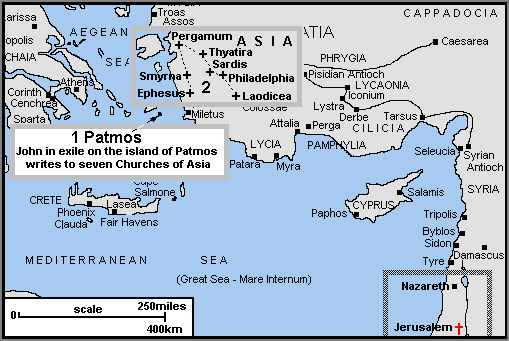A History of Evangelism
Turkey, at this moment, is a secular Islamic republic, but
in its history this country once became a part of the Roman Empire (4th
century), Byzantine (4th – 13th
century), and Latin Empire (13th century) before fell
for the Ottoman Dynasty (1453-1922)whose
King began spreading Islam in this region.
Despite today’s reality, Turkey keeps many historical trails
in Christian evangelism (the New Testament). Some of the facts worth knowing about Christianity trails are :
1. Turkey
was the birthplace of several saint/ martyrs. Saint Paul was born in Tarsus, a region on Southern Turkey, while
St.Pauls’s evangelism covered some
areas in Turkey, and also Greece and Cyprus which are neighbors. Saint Timothy, Nicholas and Polycarpus also came from Turkey.
2. Paul
and Barnabas as apostles spread the
Bible in Anthiochia region for about one year. At that time, Anthiochia was a
part of Syria . Now the area is in Turkey’s
region called Antakya. This has been the place where followers of Jesus
Christ were called ‘Christians’ for the first time(Acts 11:25-27). From Anthiochia, Paul and Barnabas conducted the
first missionary journey to Cyprus.
 |
| St.Paul's Missionary Map (source:www.ccel.org) |
3. Paul visited Galatia and Ephesus during his second missionary journey
with Silas (Acts 15:40 and so on), and also on his third
journey. Galatia and Ephesus were a part
of Turkey . Galatia is now the modern Anatolia. Paul wrote his letters to the
Christian communities in these two
places. On his second journey, Paul also came to Greek, Syria and Cicilia.
4. The
seven churches in Asia (Revelation 1:12) to whom John wrote in the Book of Revelation, were spread on seven areas of Turkey :
·
Ephesus (Revelation 2:1-7) – until now is still
called Ephesus
·
Smyrna (Revelation 2:8-11) – now Izmir, Turkey’s third largest city
·
Pergamon (Revelation 2: 12-17) – now Bergama
·
Thyatira (Revelation 2:18-29) – now Akhisar
·
Sardis (Revelation 3:1-6) – now Sart
·
Philadelphia (Revelation 3:7-13) – now Alasehir
·
Laodicea (Revelation 3:14-22), near the famous river
ofAnatolia: Lycus river
5. One
of the oldest church that’s still preserved today, Saint Peter's Church, is in Antakya (former
Anthiochia) . It was built by Saint Peter .
Saint Peter is said to stay in Anthiochia for some time. The church is
carved on a cave , and was renovated on the 19th century based on
Pope Pius IX’s order.
6. After
Jesus died , it is believed that John the Apostle brought Virgin Mary to Ephesus, on western Turkey.
Virgin Mary lived on a slope of a hill, in a small stone-walled. She lived in
the house until she died . The existence of the house was revealed from a
vision received by a German Nun, Anne Catherine Emmerich, in the beginning of 19th
century. Physical signs based on this record were then traced by two Lazarist missionary,
nearly 1 century after the Sr.Emmerich’s vision.
According to some
literature, after her death, Virgin Mary’s body was found disappeared just
like what happened to Jesus, and The Holy Virgin's Assumption has become a dogma in Catholic church.
 |
| House of Virgin Mary (source: commons.wikimedia.org) |
Today, the House of Virgin Mary
in Ephesus becomes a sacred place for both Moslems and Catholics. The House of Virgin Mary has been renovated
and inside the small house there’s a brass-colored statue of Virgin Mary, and a
small rug to kneel and pray. Taking photos inside the house is prohibited.
7. St.
John’s grave and The Basilica of St John
is located in Ephesus.
The Basilica was built on the 6th
century, on the slope of Ayasoluk Hill, near Ephesus. The church was built by
Saint John’s followers, near to his grave.
John the Apostle lived in Ephesus before being exiled to Patmos Island by
King Domitian. At Patmos, he wrote the Book of Revelation (Revelation 1:9). During King Nerva’s administration, Saint John
was released and made a comeback to Ephesus, lived there until the end of his
life.
Today this once-colossal church is only ruins, with big marble pillars
and tall walls still stand stoutly, waking imagination of how glorious this
church must had been.
 |
| St.John's Tomb Inside The Basilica |
8. In
Goreme, Cappadocia, there’re many ancient church carved on chalk cliff.
Cappadocia has a very unique landscape with many chalk cliffs. Doors, windows,
stairs, interiors, all were carved on it.
The ceilings were painted with pictures of Jesus and the Saints. These beautiful churches were developed in the 11th century, and now named as Church of the Buckle, Dark Church, Snake Church, St.Barbara's church, and Apple Church.
 |
| Outside the Church |
The ceilings were painted with pictures of Jesus and the Saints. These beautiful churches were developed in the 11th century, and now named as Church of the Buckle, Dark Church, Snake Church, St.Barbara's church, and Apple Church.
 |
| Painting Inside Apple Church |
You can visit this Goreme Open AirMuseum and get inside the churches as well.

